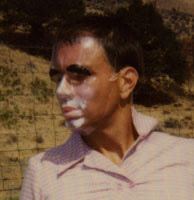Orthodox Jews devised a way of enlarging their private space in order to have a greater freedom of movement on the Shabbat, otherwise be prohibited by the Torah.
I found a nice definition on www.faqs.org since I’m reluctant to explain something I’m not much of an authority on.
Eruvs serve to create a larger private domain. In order to consider an area a private domain, the area must cover at minimum an area of about square feet and must be somehow demarcated from its surroundings, either by a wall of some sort or by virtue of its topography (that is, it is either all higher or all lower than its surroundings).
The problem was that it is impractical to build a continuous solid wall around a community. However, the Rabbis noticed that doors are permitted within walls, and that a doorway consists of two parts: the vertical members and the lintel on top. In fact, a wall may have quite few doors, and still be considered to enclose an area. In the limiting case, there are many doorway openings and having very little of solid wall remaining.
This is what happens in an Eruv. The door post function is fulfilled by telephone (utility) poles (serving as vertical members), with the lintel being cables strung between the poles. However, for a door post/lintel combination to be acceptable, the lintel must rest directly above the top of the doorposts. Note that this is not the typical approach in utility poles, where the cable is attached either to the side or to a member held away from the pole. To address this, there is often a thin rod attached onto the pole to serve as the door post “surrogate” (“lechi”). Additionally, the line that serves as the lintel needs to be the lowest of the lines on the pole. If it is not, then it is necessary to string a new length of line between the affected set of poles.
They’re all over New York but because string is rather difficult to spot amidst the complicated visual palette of the city, I’ve seldom seen any. I spotted this one on the way to the 190th Street subway station, connecting the rock face to a light pole about a hundred yards away. A few issues back Harpers featured a fine visual explanation in pdf format.
I found a nice definition on www.faqs.org since I’m reluctant to explain something I’m not much of an authority on.
Eruvs serve to create a larger private domain. In order to consider an area a private domain, the area must cover at minimum an area of about square feet and must be somehow demarcated from its surroundings, either by a wall of some sort or by virtue of its topography (that is, it is either all higher or all lower than its surroundings).
The problem was that it is impractical to build a continuous solid wall around a community. However, the Rabbis noticed that doors are permitted within walls, and that a doorway consists of two parts: the vertical members and the lintel on top. In fact, a wall may have quite few doors, and still be considered to enclose an area. In the limiting case, there are many doorway openings and having very little of solid wall remaining.
This is what happens in an Eruv. The door post function is fulfilled by telephone (utility) poles (serving as vertical members), with the lintel being cables strung between the poles. However, for a door post/lintel combination to be acceptable, the lintel must rest directly above the top of the doorposts. Note that this is not the typical approach in utility poles, where the cable is attached either to the side or to a member held away from the pole. To address this, there is often a thin rod attached onto the pole to serve as the door post “surrogate” (“lechi”). Additionally, the line that serves as the lintel needs to be the lowest of the lines on the pole. If it is not, then it is necessary to string a new length of line between the affected set of poles.
They’re all over New York but because string is rather difficult to spot amidst the complicated visual palette of the city, I’ve seldom seen any. I spotted this one on the way to the 190th Street subway station, connecting the rock face to a light pole about a hundred yards away. A few issues back Harpers featured a fine visual explanation in pdf format.



